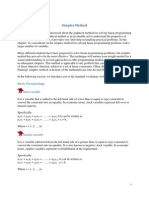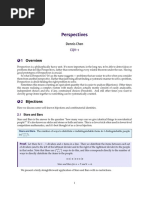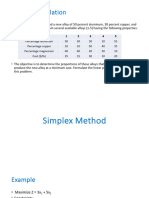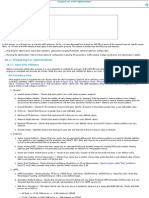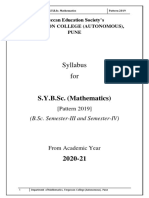0 ratings0% found this document useful (0 votes)
33 views3.2 Unconstrained Optimization Multiple Variables
This document discusses unconstrained optimization problems involving multiple variables. It uses the example of a Cournot duopoly to demonstrate how to set up and solve an optimization problem with two choice variables (quantity for each of two firms). The optimization problems are set up by defining the profit functions for each firm in terms of their own and the other firm's quantity. Taking derivatives of the profit functions yields a system of first-order conditions that can be solved to find the profit-maximizing quantities. The Hessian matrix is then used to check that these quantities represent a maximum rather than a minimum.
Uploaded by
SHYAM SUNDARCopyright
© © All Rights Reserved
Available Formats
Download as PDF, TXT or read online on Scribd
0 ratings0% found this document useful (0 votes)
33 views3.2 Unconstrained Optimization Multiple Variables
This document discusses unconstrained optimization problems involving multiple variables. It uses the example of a Cournot duopoly to demonstrate how to set up and solve an optimization problem with two choice variables (quantity for each of two firms). The optimization problems are set up by defining the profit functions for each firm in terms of their own and the other firm's quantity. Taking derivatives of the profit functions yields a system of first-order conditions that can be solved to find the profit-maximizing quantities. The Hessian matrix is then used to check that these quantities represent a maximum rather than a minimum.
Uploaded by
SHYAM SUNDARCopyright
© © All Rights Reserved
Available Formats
Download as PDF, TXT or read online on Scribd
You are on page 1/ 11
Unconstrained Optimization:
Multiple Variables
Basic Math for Economics – Refresher
Eric Dunaway epdunaway@gmail.com 1
Introduction
While working with just one variable is simple, it’s rare in
economics.
Often, we must work with many variables all at the same
time.
This complicates our optimization slightly, but the same rules
still apply.
Let’s take a look at another unconstrained optimization
problem, but this time through the lens of a Cournot duopoly.
Recallthat in a Cournot duopoly, two firms simultaneously
choose their quantities, but face the same market price.
Eric Dunaway epdunaway@gmail.com 2
Unconstrained Optimization
Let’s use the same market as last time, but rather than there
being a monopolist, now there are two firms and they
compete in quantities.
Both firms face the inverse demand function
𝑝 = 250 − 2𝑞1 − 2𝑞2
and face constant marginal costs of production of 𝑐 = 50.
As before, we will set up our problem and then optimize.
Note that we actually have two optimization problems here.
Each firm is maximizing their profits separately, so we
need to treat them as separate optimization decisions.
Eric Dunaway epdunaway@gmail.com 3
Unconstrained Optimization
Let’s start with firm 1.
They want to maximize their profits, and the only thing
they can choose is their own quantity, 𝑞1 . Thus, we
have,
max
𝑞1
Next, they want to maximize their own profits (they
don’t care about firm 2’s profits at all), but their inverse
demand function is also a function of firm 2’s quantity,
so we must include it.
max 250 − 2𝑞1 − 2𝑞2 𝑞1 − 50𝑞1
𝑞1
Eric Dunaway epdunaway@gmail.com 4
Unconstrained Optimization
max 250 − 2𝑞1 − 2𝑞2 𝑞1 − 50𝑞1
𝑞1
From here, we can calculate a first-order condition as before
(remember to treat 𝑞2 as a constant),
𝜕𝜋1
= 250 − 4𝑞1 − 2𝑞2 − 50 = 0
𝜕𝑞1
We can perform the same analysis for firm 2, obtaining the following
optimization problem,
max 250 − 2𝑞1 − 2𝑞2 𝑞2 − 50𝑞2
𝑞2
and first-order condition,
𝜕𝜋2
= 250 − 2𝑞1 − 4𝑞2 − 50 = 0
𝜕𝑞2
Eric Dunaway epdunaway@gmail.com 5
Unconstrained Optimization
𝜕𝜋1
= 250 − 4𝑞1 − 2𝑞2 − 50 = 0
𝜕𝑞1
𝜕𝜋2
= 250 − 2𝑞1 − 4𝑞2 − 50 = 0
𝜕𝑞2
This is just a system of two equations and two unknowns
and fairly easy to solve.
Doing so yields 𝑞1∗ = 𝑞2∗ = 33.3, which is notable smaller
than what a monopolist produces (which is expected).
Westill need to check whether this is a maximum,
however.
Eric Dunaway epdunaway@gmail.com 6
Unconstrained Optimization
𝜕𝜋1
= 250 − 4𝑞1 − 2𝑞2 − 50 = 0
𝜕𝑞1
𝜕𝜋2
= 250 − 2𝑞1 − 4𝑞2 − 50 = 0
𝜕𝑞2
This is a bit harder, and requires the use of a matrix called the Hessian.
To calculate the Hessian, we need to take a derivative of each of our
first-order conditions for each of our choice variables (4 derivatives
total in this case).
The first row and first column of our Hessian is the derivative of our
first first-order condition for our first variable.
Thefirst row and second column of our Hessian is the derivative of
our first first-order condition for our second variable.
Eric Dunaway epdunaway@gmail.com 7
Unconstrained Optimization
Calculating these derivatives,
𝜕 2 𝜋1 𝜕 2 𝜋1
2 = −4 𝜕𝑞1 𝜕𝑞2
= −2
𝜕𝑞1
𝐻=
𝜕 2 𝜋2 𝜕 2 𝜋2
= −2 2 = −4
𝜕𝑞2 𝜕𝑞1 𝜕𝑞2
Or, reducing this matrix a little bit, we have
−4 −2
𝐻=
−2 −4
Our problem is maximized if this matrix is negative
semidefinite.
Eric Dunaway epdunaway@gmail.com 8
Unconstrained Optimization
−4 −2
𝐻=
−2 −4
Negative semidefinite?
Leaving out most of the math, it means that certain
elements of the Hessian must take certain values.
For a 2x2 matrix, if all the elements along the trace are
less than or equal to zero and the determinant is positive,
then the matrix is negative semidefinite.
First,
let’s check the trace. Both elements along the
trace are equal to −4, so they satisfy the requirement
that they are less than or equal to zero.
Eric Dunaway epdunaway@gmail.com 9
Unconstrained Optimization
−4 −2
𝐻=
−2 −4
Now, let’s calculate the determinant.
𝐻 = −4 −4 − −2 −2 = 16 − 4 = 12
Since the determinant of the Hessian is positive, that
along with all the elements of our trace being negative
means that our matrix is negative semidefinite and we
have a maximum rather than a minimum.
It’s
useful to check this when dealing with less
behaved functional forms.
Eric Dunaway epdunaway@gmail.com 10
Unconstrained Optimization
If you are looking for a minimum, rather than a maximum,
the Hessian needs to be positive semidefinite.
For a 2x2 Hessian, all the elements along the trace must
be greater than or equal to zero while the determinant
is still positive.
If we move beyond a 2x2 Hessian (i.e., we have more
than two choice variables), this becomes more
complicated.
Our principal minors must have alternating signs based
upon which minor they are.
A linear algebra course would be helpful for this.
Eric Dunaway epdunaway@gmail.com 11
You might also like
- v2 - Algebra II (Common Core) Regents Review Sheet - Facts You Must Know Cold100% (1)v2 - Algebra II (Common Core) Regents Review Sheet - Facts You Must Know Cold19 pages
- 15.053 February 22, 2007: Introduction To The Simplex AlgorithmNo ratings yet15.053 February 22, 2007: Introduction To The Simplex Algorithm62 pages
- Dr. Joon-Yeoul Oh: IEEN 5335 Principles of OptimizationNo ratings yetDr. Joon-Yeoul Oh: IEEN 5335 Principles of Optimization33 pages
- A. Exponential Equation, Inequalities and FunctionNo ratings yetA. Exponential Equation, Inequalities and Function8 pages
- Unit 2 - Divide and Conquer & Greedy StrategyNo ratings yetUnit 2 - Divide and Conquer & Greedy Strategy45 pages
- UCK 337 Introduction To Optimization Spring 2019-2020 Problem Set INo ratings yetUCK 337 Introduction To Optimization Spring 2019-2020 Problem Set I3 pages
- 6-Standard form, Canonical Form, Basic Terminology-03-01-2025No ratings yet6-Standard form, Canonical Form, Basic Terminology-03-01-202512 pages
- Manonmaniam Sundaranar University: B.Sc. Mathematics - Iii YearNo ratings yetManonmaniam Sundaranar University: B.Sc. Mathematics - Iii Year76 pages
- PART 1 -GENERAL MATHEMATICS 1- POLYNOMIALS AND LINEAR FUNCTIONS - LECTURE NOTESNo ratings yetPART 1 -GENERAL MATHEMATICS 1- POLYNOMIALS AND LINEAR FUNCTIONS - LECTURE NOTES38 pages
- Class 1 - Class 2- Class 3 Expressions-And-EquationsNo ratings yetClass 1 - Class 2- Class 3 Expressions-And-Equations15 pages
- Solving One-Variable Inequalities 9.1.1 and 9.1.2: Example 1No ratings yetSolving One-Variable Inequalities 9.1.1 and 9.1.2: Example 153 pages
- Simplex Method - 4th Semester - Numerical Programming100% (1)Simplex Method - 4th Semester - Numerical Programming37 pages
- 1 Linear Equations With and Without Fractions (Key)No ratings yet1 Linear Equations With and Without Fractions (Key)5 pages
- Linear Programming (Chapter 11) : No Problem Can Stand The Assault of Sustained ThinkingNo ratings yetLinear Programming (Chapter 11) : No Problem Can Stand The Assault of Sustained Thinking14 pages
- Solving Linear Equations - Absolute ValueNo ratings yetSolving Linear Equations - Absolute Value6 pages
- Optimization Lesson 2 - Constrained Multi-Variable OptimizationNo ratings yetOptimization Lesson 2 - Constrained Multi-Variable Optimization31 pages
- Chapter 4 Duality and Post Optimal AnalysisNo ratings yetChapter 4 Duality and Post Optimal Analysis37 pages
- Operations Research: Integer ProgrammingNo ratings yetOperations Research: Integer Programming42 pages
- Ozturk-2013-Effect-of-type-and-relative-amount-No ratings yetOzturk-2013-Effect-of-type-and-relative-amount-15 pages
- SCHWINGSHACKI_ALTERNATIVE_DYNAMIIC_METHODNo ratings yetSCHWINGSHACKI_ALTERNATIVE_DYNAMIIC_METHOD7 pages
- Manoharan-2019-Experimental-investigation-on-the-tNo ratings yetManoharan-2019-Experimental-investigation-on-the-t15 pages
- Su2015_Article_TribologicalBehaviorOfCopperGrNo ratings yetSu2015_Article_TribologicalBehaviorOfCopperGr12 pages
- 1.different Hip Implant Designs Along With Femur Under Static Loading ConditionsNo ratings yet1.different Hip Implant Designs Along With Femur Under Static Loading Conditions10 pages
- 04.2 Applications of Derivatives (Word Problems) Rev2018No ratings yet04.2 Applications of Derivatives (Word Problems) Rev20185 pages
- SPSS Statistics, Factor Analysis, Cluster Analysis, LInear Regression, HEC, Xavier Boute, MBANo ratings yetSPSS Statistics, Factor Analysis, Cluster Analysis, LInear Regression, HEC, Xavier Boute, MBA8 pages
- DPP-2 Application of Derivatives: IIT PaceNo ratings yetDPP-2 Application of Derivatives: IIT Pace7 pages
- CH 6 Applications of Derivatives Multiple Choice Questions With Answers100% (1)CH 6 Applications of Derivatives Multiple Choice Questions With Answers6 pages
- Continuity and Differentiability: FX Fa X ANo ratings yetContinuity and Differentiability: FX Fa X A1 page
- OQM Lecture Note - Part 8 Unconstrained Nonlinear OptimisationNo ratings yetOQM Lecture Note - Part 8 Unconstrained Nonlinear Optimisation23 pages
- v2 - Algebra II (Common Core) Regents Review Sheet - Facts You Must Know Coldv2 - Algebra II (Common Core) Regents Review Sheet - Facts You Must Know Cold
- 15.053 February 22, 2007: Introduction To The Simplex Algorithm15.053 February 22, 2007: Introduction To The Simplex Algorithm
- Dr. Joon-Yeoul Oh: IEEN 5335 Principles of OptimizationDr. Joon-Yeoul Oh: IEEN 5335 Principles of Optimization
- A. Exponential Equation, Inequalities and FunctionA. Exponential Equation, Inequalities and Function
- UCK 337 Introduction To Optimization Spring 2019-2020 Problem Set IUCK 337 Introduction To Optimization Spring 2019-2020 Problem Set I
- 6-Standard form, Canonical Form, Basic Terminology-03-01-20256-Standard form, Canonical Form, Basic Terminology-03-01-2025
- Manonmaniam Sundaranar University: B.Sc. Mathematics - Iii YearManonmaniam Sundaranar University: B.Sc. Mathematics - Iii Year
- PART 1 -GENERAL MATHEMATICS 1- POLYNOMIALS AND LINEAR FUNCTIONS - LECTURE NOTESPART 1 -GENERAL MATHEMATICS 1- POLYNOMIALS AND LINEAR FUNCTIONS - LECTURE NOTES
- Class 1 - Class 2- Class 3 Expressions-And-EquationsClass 1 - Class 2- Class 3 Expressions-And-Equations
- Solving One-Variable Inequalities 9.1.1 and 9.1.2: Example 1Solving One-Variable Inequalities 9.1.1 and 9.1.2: Example 1
- Simplex Method - 4th Semester - Numerical ProgrammingSimplex Method - 4th Semester - Numerical Programming
- 1 Linear Equations With and Without Fractions (Key)1 Linear Equations With and Without Fractions (Key)
- Linear Programming (Chapter 11) : No Problem Can Stand The Assault of Sustained ThinkingLinear Programming (Chapter 11) : No Problem Can Stand The Assault of Sustained Thinking
- Optimization Lesson 2 - Constrained Multi-Variable OptimizationOptimization Lesson 2 - Constrained Multi-Variable Optimization
- Quadratic Equation: new and easy way to solve equationsFrom EverandQuadratic Equation: new and easy way to solve equations
- Attacking Problems in Logarithms and Exponential FunctionsFrom EverandAttacking Problems in Logarithms and Exponential Functions
- Manoharan-2019-Experimental-investigation-on-the-tManoharan-2019-Experimental-investigation-on-the-t
- 1.different Hip Implant Designs Along With Femur Under Static Loading Conditions1.different Hip Implant Designs Along With Femur Under Static Loading Conditions
- 04.2 Applications of Derivatives (Word Problems) Rev201804.2 Applications of Derivatives (Word Problems) Rev2018
- SPSS Statistics, Factor Analysis, Cluster Analysis, LInear Regression, HEC, Xavier Boute, MBASPSS Statistics, Factor Analysis, Cluster Analysis, LInear Regression, HEC, Xavier Boute, MBA
- CH 6 Applications of Derivatives Multiple Choice Questions With AnswersCH 6 Applications of Derivatives Multiple Choice Questions With Answers
- OQM Lecture Note - Part 8 Unconstrained Nonlinear OptimisationOQM Lecture Note - Part 8 Unconstrained Nonlinear Optimisation



































